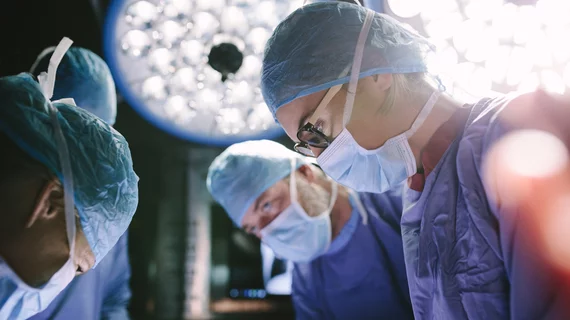Surgeons warn it is too early to recommend a TAVR-first strategy for low-risk patients
Updates on the potential benefits of transcatheter aortic valve replacement (TAVR) among low-risk patients with severe aortic stenosis was one of the biggest stories to come out of TCT 2023 in San Francisco. New data from the PARTNER 3 and Evolut Low Risk trials suggest TAVR could be equal—or even superior—to surgical aortic valve replacement (SAVR) for treating this patient population.
According to the Society of Thoracic Surgeons (STS) and European Association for Cardio-Thoracic Surgery (EACTS), however, “could” is a crucial word when considering these trials. They say it is still too early to reach any final conclusions about the long-term safety and effectiveness of TAVR, especially when comparing it to SAVR.
“TAVR has proven to be an excellent innovation, particularly for patients of advanced age or risk, that all surgeons and cardiologists unequivocally support through proper functioning multi-disciplinary heart teams,” the two groups wrote in a joint statement. They added, though, that the PARTNER 3 update focused on five-year data, and the Evolut Low Risk update focused on four-year data, which does not represent enough information to fully understand how low-risk patient will hold up following TAVR.
One key takeaway from the STS/EACTS statement is that, using the same inclusion criteria found in the PARTNER 3 and Evolut Low Risk trials, SAVR is already associated with a survival rate of nearly 93% after five years among low-risk patients treated in a real-world setting. After eight years, the groups added, survival remains close to 90%.
“These data provide the real-world benchmark from which to interpret current and future analyses in low-risk patients receiving therapy for aortic stenosis,” the groups wrote.
The two medical societies said more follow-up data from these trials is required before accurate comparisons can be made between TAVR and surgery. The groups also explained that many of the surgical patients included in the PARTNER 3 and Evolut Low Risk trials underwent other procedures in addition to SAVR. They said this makes it even harder to compare outcomes associated with the two treatment techniques.
“Given that the fastest growing operation in the STS National Database over the last five years is TAVR explantation or surgery after TAVR, STS and EACTS would advise that more follow-up time be given from the existing low-risk trials prior to embracing TAVR’s clinical utility in low-risk patients,” the two groups concluded. “Furthermore … we call on investigators from both the PARTNER 3 and Evolut Low-Risk trials to publish their results for the isolated SAVR and isolated TAVR sub-cohorts from their trial arms. Until we have this data, any statements or conclusions from these trials are interesting, but still hypothesis generating and speculative. STS and EACTS therefore recommend caution prior to adopting a TAVR-first strategy in low-risk patients, particularly those patients with characteristics not specifically studied in these low-risk trials.”
Additional context about SAVR vs. TAVR
Kendra Grubb, MD surgical director of the Emory Structural Heart and Valve Center and associate professor of surgery with the Emory University School of Medicine, is one of the leading cardiac surgery experts in the United States. She was on hand at TCT 2023 and spoke to Cardiovascular Business about how she views TAVR and SAVR at this point in time. Click here to watch the full video interview.

